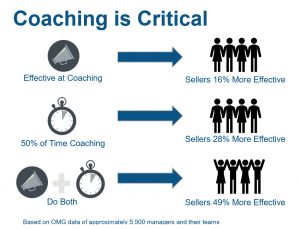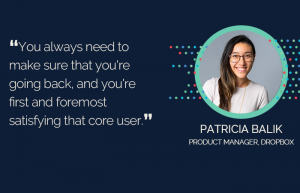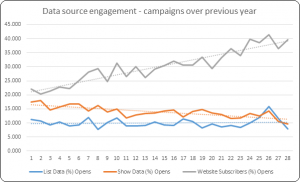— August 21, 2018
One of the hardest things for any growing agency is capturing leads at scale. In this guide, we’ll share unbeatable tactics you can use to grow not just a handful, but hundreds of leads. Read on to learn how.
You’ve got a finely optimized suite of services. Your project management systems are top-notch. And your operations are humming at an industrial pace.
Except there is a problem: your sales pipeline is completely dry.
Leads are the fuel to your agency’s growth engine. The most finely optimized system can’t yield any results if you don’t supply it with a steady stream of leads.
But far too often, agencies pursue unscalable lead generation tactics. Referrals, cold outreach, and haphazard content marketing approaches dominate. These might work, but they’re hard to predict and even harder to scale.
What you need is a scalable approach to lead generation.
Below, I’ll share 12 tactics to acquire leads at scale, covering everything from organic search to directories and social media.
1. Create Landing Pages for Long-Tail Keywords
The agency formula for creating landing pages is often the same. The homepage leads to service pages, each of which targets a broad and highly competitive keyword (such as “SEO” or “content marketing”).
While these landing pages can give website visitors a good idea of what you offer, they can’t help attract any traffic.
Further, because of their broad focus, they don’t do a good job of pitching your services to niche customers. Do you offer “content marketing” services to only enterprise customers, or do you also serve small startups?
Your visitors have no idea, which can turn them away.
To solve this problem, create more targeted landing pages.
For example, Foxtail Marketing has landing pages for all the niche industries it serves:
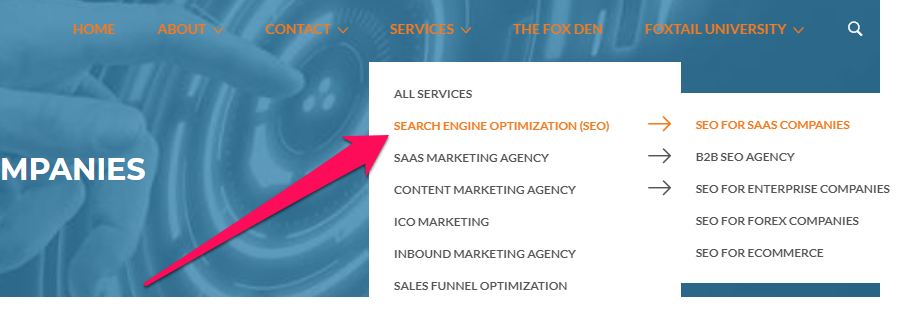
(Image credit: FoxtailMarketing)
This helps in two ways:
- It educates Foxtail’s website visitors about its range of services and industry focus
- It helps Foxtail attract traffic from long-tail search queries (the site ranks #2 for “SEO for forex companies”)
Further, since the landing pages are highly targeted, leads acquired through them will be of a better quality as well. Anyone searching for “SEO for SaaS businesses” is most likely a SaaS company looking for SEO help.
In fact, HubSpot’s research shows that the more landing pages you create, the more leads you’ll capture.
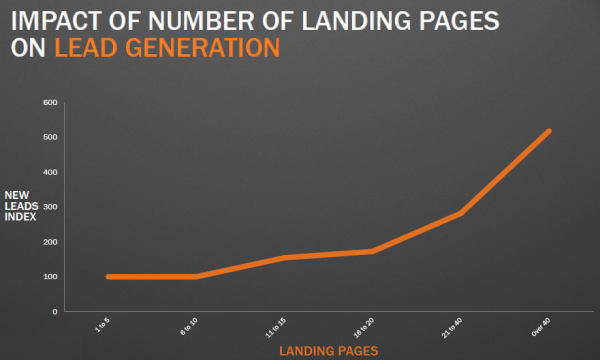
(Image credit: HubSpot)
If you’re going to adopt this tactic, keep two things in mind:
- Add at least 500+ words of content to the landing page to increase your ranking chances
- Create separate pages for:
- Industries (“SEO for e-commerce”)
- Geographies (“SEO in Austin”),
- A combination of the two (“SEO for e-commerce companies in atlanta”).
The best part about this tactic is that you can use the same content template for every landing page. Thus, you can quickly build out dozens of landing pages covering all areas of expertise to land leads at scale.
2. Create Content Upgrades Based on Search Intent
If you’ve been around our website, you might have noticed these boxes on some blog posts:
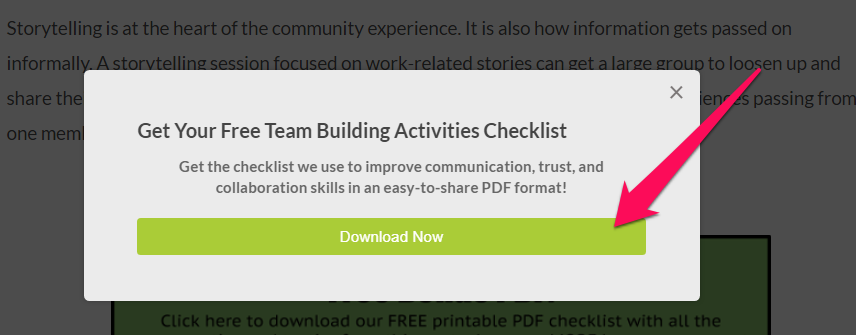
This is a “content upgrade”.
A content upgrade, as I mentioned in my email marketing guide, is a downloadable document that “upgrades” the experience of the current content by:
- Offering additional material such as tips, advice, etc.
- Condensing existing content into a friendlier format
In the above example, we condensed the article into a short, two-page PDF. Visitors can access it after sharing their email address:
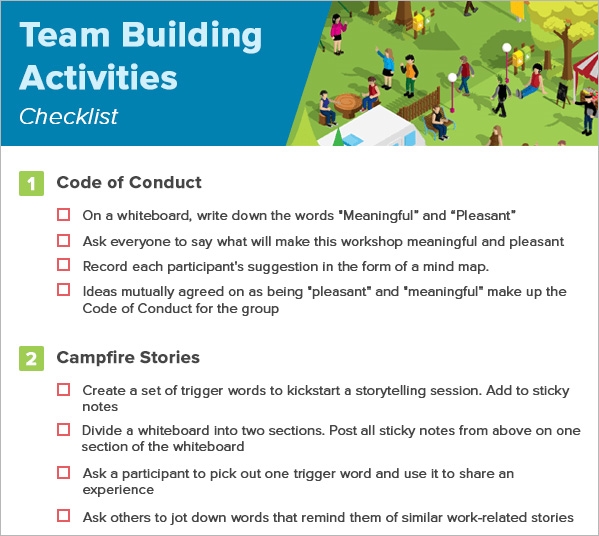
Content upgrades are great for capturing leads because they are contextually relevant. A person reading an article about “team building activities” is also likely interested in downloading a PDF with a list of such activities.
Because of this, content upgrades often get conversion rates close to 10%.
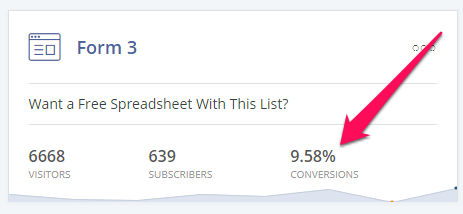
(Image credit: MIDINation)
For a content upgrade to be effective, it needs to be highly targeted. It should answer the question: “What does the reader want from this article?”
One way to figure this out is to use search intent.
Here’s how: log into your Google Webmaster Tools account. Go to Search Traffic > Search Analytics. Select the ‘Pages’ radio button and click on a high-traffic web page.

Once selected, click ‘Queries’. This will show you a list of keywords people used to find the page.
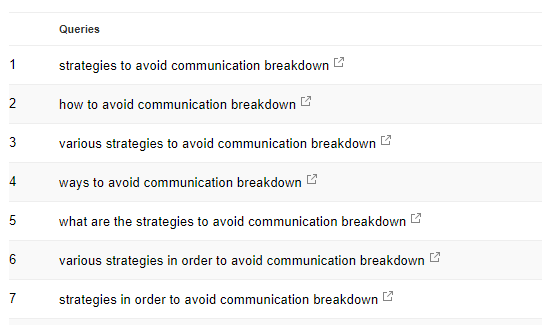
Any content upgrade that focuses on these keywords will be contextually relevant.
You can do this for all your top-performing pages to capture leads at scale with targeted content upgrades.
3. Update Existing Pages to Increase Traffic
You might have noticed that Google shows the date of publication (when available) for every query:
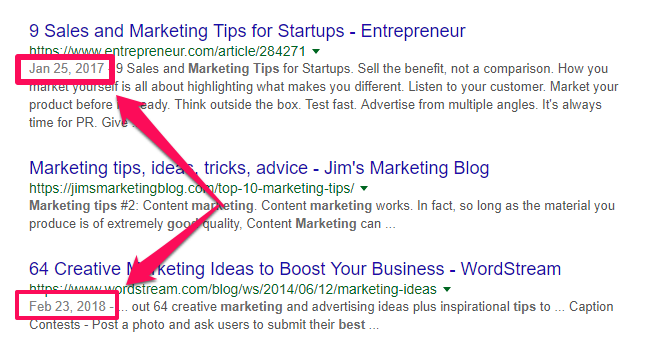
Unsurprisingly, most top results are recently published or updated.
This is part of Google’s push to prioritize recency in its algorithm. This is particularly true for time-sensitive topics where a 5-year old page might not have the most relevant information.
You can take advantage of this change by updating your existing pages with newer content. This can push articles languishing on page 2 and 3 to the 1st page, increasing your traffic.
Further, since updating a page requires far less effort than creating a new one, this is an easy tactic to scale across your entire content library.
Here’s how to use it:
Log into your Google Analytics account and head to Behavior > Site Content > All Content. Look for pages that:
- Have low traffic
- Have low bounce rate and high average time on page
- Are focused on topics that can change over time (“SEO tips” can change, “What is SEO” is evergreen)
Once you’ve found these pages, update them with fresh content. Add a content upgrade to them if possible.
You’ll find that a lot of these pages will automatically rank better within a few weeks.
For instance, we used this tactic to improve traffic to this page from 400 to 1,000+ pageviews in just four months.

4. Offer Free Audits, Tools, and Consultations
A month ago, we surveyed 122 agency websites to evaluate their pricing and sales tactics.
We found that a large number of agencies, especially digital and SEO agencies, were offering free consultations or audits to capture leads:
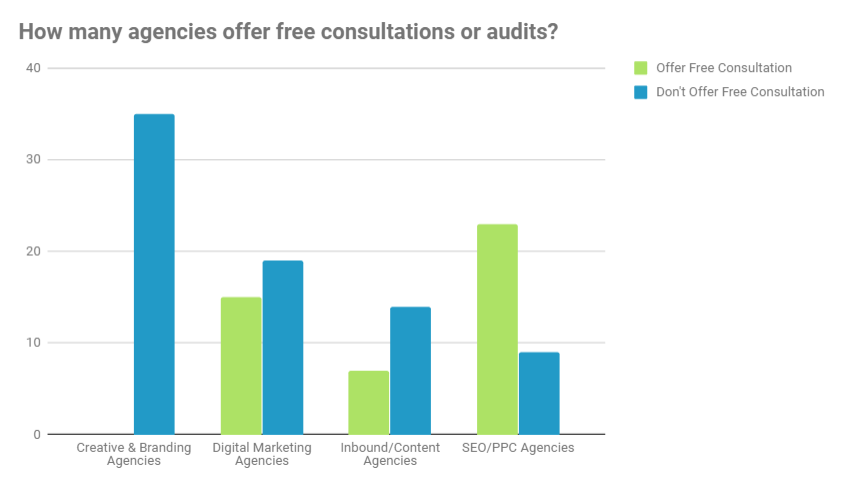
Offering free things is old hat as far as lead generation goes. But free audits and consultations have the added benefit of tying directly into the sales process.
When you offer a free consultation, you don’t just get an email and a phone number; you get a chance to get the prospect on the phone. This cuts the qualification process drastically – you’ll know within minutes into a conversation whether a prospect is likely to convert or not.
Similarly, offering a free audit helps you check whether a prospect’s business is a good fit for your agency.
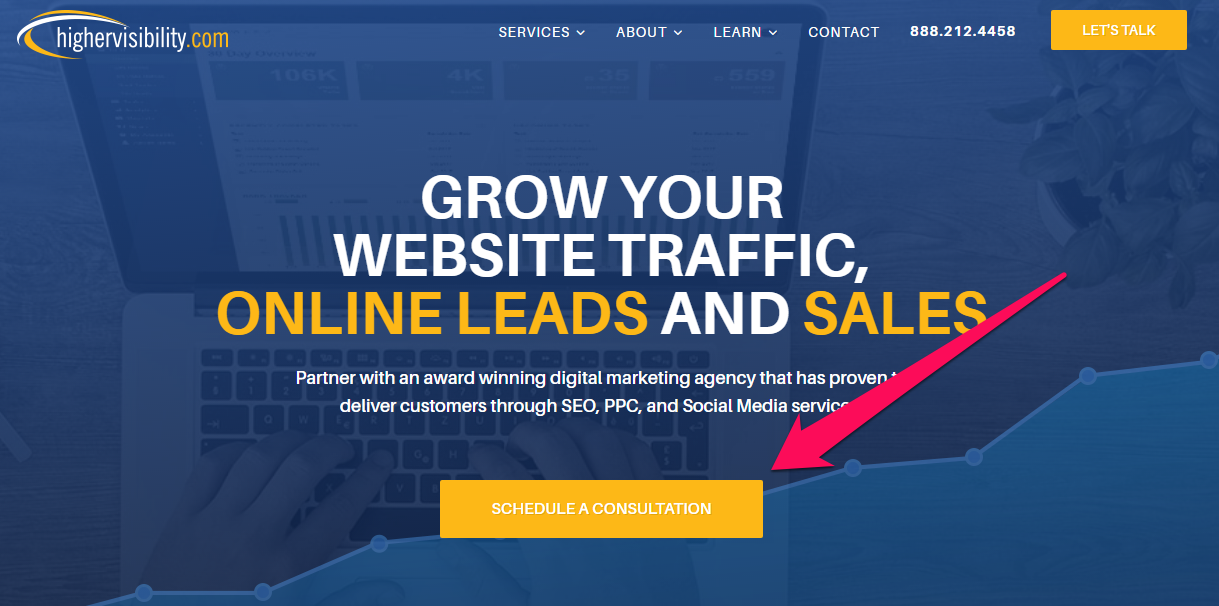
An example of an SEM agency offering a free consultation (Image source; HigherVisibility)
In our roundup of agency marketing tips, Kevin Simonson of Metric Digital spoke about the importance of free audits for his agency.
“Our agency’s top client acquisition strategy is to offer a free marketing audit. There’s no commitment from the prospective client, and they get great advice. Plus we always learn a ton about digital marketing and how brands work.”
Untargeted leads will be a problem, of course, especially if you have a lot of traffic. But if you’re struggling with lead volume, this can be a viable tactic to get more prospects into the pipeline while cutting short the qualification process.
4. Develop Strategic Partnerships
Instead of capturing leads on your own, how about “borrowing” them from other companies?
By developing partnerships with related companies, you can both serve your clients better. A SEO agency can partner with a creative agency to offer design services to its clients. And the creative agency can expand its services to include SEO.
This mutual exchange of expertise helps everyone – you, your partners, and your clients.
As an agency, your partners will fall into three buckets:
- Other agencies offering non-competing services in related or tangential industries.
- Software providers offering tools that align with your agency’s services.
- Service providers offering services (such as web hosting) that require help from agencies.
Partnering with software or service providers is a time-honored agency practice (think of Google Partners or HubSpot Certified Agencies). While these can be lucrative, the high visibility and lower barriers to entry makes these partnerships not quite as fruitful as the ones you can strike with other agencies.
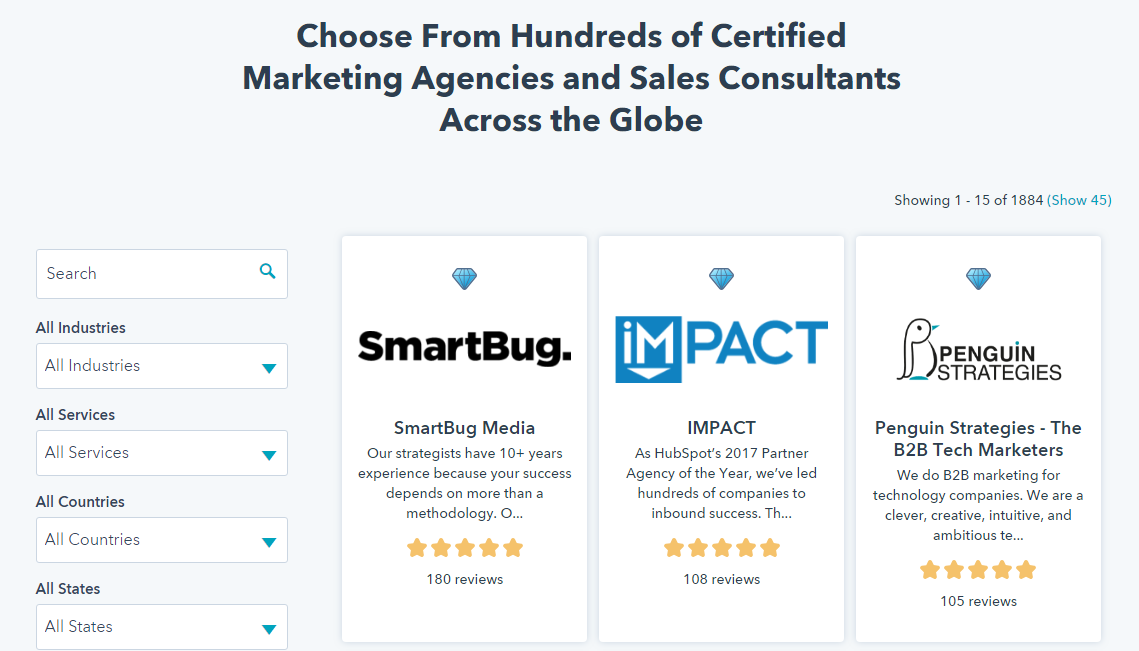
Above: HubSpot’s Certified Agency program (Image credit: HubSpot)
When you consider other agencies for partnerships, two factors should guide your search:
- Service gaps: Look for agencies that have an obvious gap in their services. Say, they offer SEM but don’t have a design team on hand.
- Reciprocity: A partnership means you have to give something in return. Ask yourself: what can you offer, and what are you willing to give up? Most likely, you will have to offer free services or leads of a similar quality.
Your ideal partner is someone slightly larger than you in a tangential, non-competing industry. You want people who can introduce you to a whole new subset of clients. For instance, if you work primarily with insurance clients, look for a partner in the pet supplies space.
Don’t fret about competition. As Julien Brandt of Organik SEO says, “I feel like there is plenty of business out there for everyone and many agencies and service providers serve the same vertical in a different capacity.”
Once you do strike a partnership, extend it further by:
- Collaborating on content, especially high-value offerings such as webinars
- White-labeling some high-volume services that have a low strategic impact (such as content creation)
5. Use Niche Directory Listings
Want leads without the effort of attracting them?
Then you need to get listed on niche agency directories.
Agency directories such as Clutch.co, UpCity, and DigitalAgencyNetwork have access to a massive pool of traffic. There a pre-selection effect in place as well – anyone searching on these directories is already interested in buying agency services.
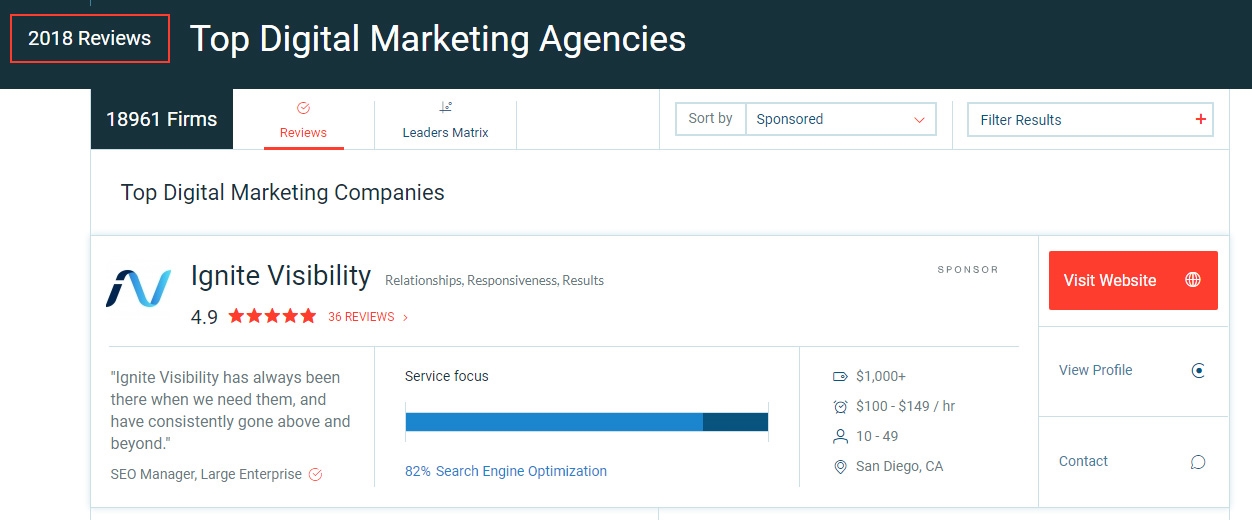
An example of an agency listings page on Clutch (Image credit: Clutch.co)
As Les Kollegian of Jacob Tyler says:
“The most effective way we find clients is by helping clients find us. We have asked our bigger clients to provide reviews of our services on clutch.co…which has given us credibility to prospects who have not heard of our firm.”
Unless you’re willing to pay (which can be worthwhile if you understand your M-CAC and CLTV), you’ll have to invest some effort to spruce up your listing.
Here’s what David Gaz says about directory listings:
“The key is to build a relationship with the people who run the directories and develop a compelling profile. It’s a symbiotic relationship because they need you as much as you need them. The reviews that your clients post and the quality of your work are what drive traffic to their site, which in turn collectively drives leads to you.”
The hardest part is getting reviews. Approach this the same way you would approach getting referrals, i.e.:
- Identify your top clients through qualitative feedback or tools such as NPS scores
- Ask for reviews at positive moments in the relationship – project close, meeting key deadlines, etc.
- Incentivize reviews by offering discounts or free services (mention the incentive in the actual review so that you don’t flout the directory’s rules)
The quality of the reviews matters as much as the quantity. It’s better to get 5 in-depth reviews from trusted clients than to get 20 shallow ones from non-descript companies.
6. Automate Outbound Campaigns
A sophisticated outbound sales campaign isn’t just about cold calling prospects. Rather, it is about building a sales engine that can identify targeted leads and pitch them relevant offers, at scale.
The core ingredients of this engine are:
- Identifying prospects at scale
- Scheduling personalized messages
- Continuous improvement through A/B testing
For the first part – prospecting – you need to find businesses that fit your target client persona. Use tools like Manta (location, size), Datanyze, BuiltWith, and CrunchBase to create separate lists of targets based on their:
- Technology use
- Company size
- Location
- Industry
Prioritize targets that find a spot in multiple lists (such as a company that uses WordPress, makes $ 10M in revenue, and is located in your city). Once you find these high-value targets, augment data using Salesforce, Pardot, or Datanyze to find decision makers.
Use tools like GrowBots to automate messaging at scale. For a cheaper alternative, try MailShake.
Instead of writing every message from scratch, create templatse that allows room for “minimally effective personalization”. That is, a message with just enough personalization to appear hand-crafted.
For example, this template from FreshSales can pull in data from a CRM automatically. The only field you actually need to personalize is the highlighted benefit statement:
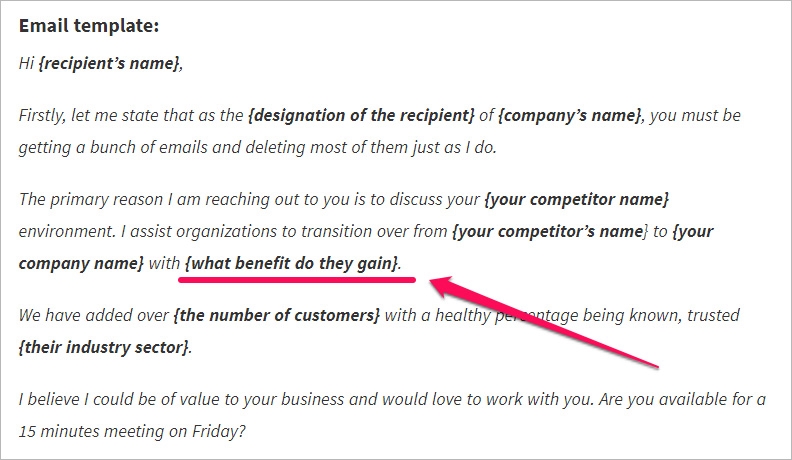
An example of a personalized email template (Image credit: FreshSales)
Along with automated scheduling, this limited personalization is crucial for achieving scale in your outbound campaigns.
7. Use Facebook Ads with Remarketing to Retain Interest
Hiring an agency isn’t an impulse buy. Companies deliberate extensively before deciding who to work with.
Given the long sales cycle, it is crucial that you retain your prospects’ interest over time. It’s not enough to make a favorable impression on first touch; you have to maintain top-of-mind-awareness (TOMA) throughout the cycle.
An affordable, non-interruptive way to do this is through remarketing, especially when its paired with targeted content.
Here’s a simplified process to do this:
- Set up a targeted Facebook ad campaign sharing a targeted content piece
- Add a lead magnet to capture leads from the content
- Add remaining visitors to a remarketing campaign
You can expand this by sending all captured leads to a more aggressive remarketing campaign.
For example, Ax Agency advertised an article on ‘fatal marketing mistakes’ as part of its Christmas promotions:
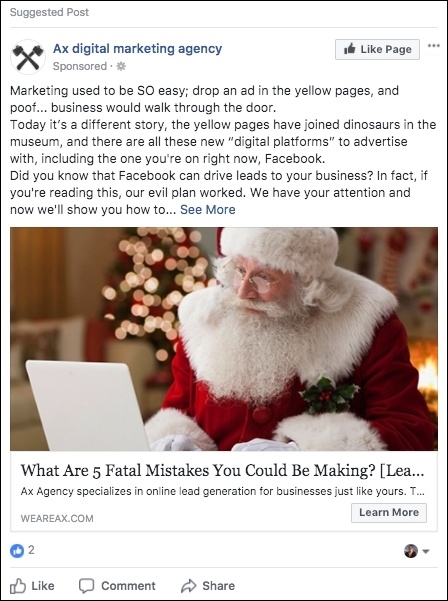
(Image credit: FunnelDash)
The trick to make remarketing work is to bid low for ads and high for the remarketing. This eliminates low-interest prospects. If someone is engaging with you a second time (through the remarketing campaign), they’re more likely to be interested in your services.
As David Gaz said in our previous article on the best agency marketing tips:
“Bid low for the ads, and bid high for the remarketing. Once they click on the remarketing ads they are almost certainly a client.”
8. Repurpose Content and Distribute Off-Site
Content marketing can be one of your most powerful sources of new leads. But by publishing only on your own site, you’re greatly limiting the reach of your content.
Repurposing your content and sharing it on high-traffic sites – Slideshare, Quora, LinkedIn, etc. – can give you access to entirely new audiences. Pair this repurposed content with the right lead magnets, and they can turn into a goldmine of new leads.
For example, we repurpose our blog posts on LinkedIn that generate hundreds of additional views every week. Not bad for a few minutes of work!
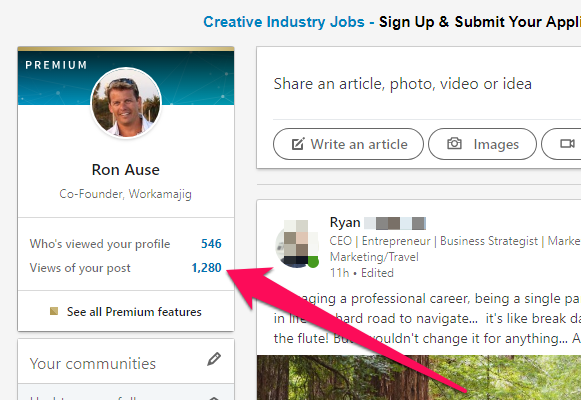
Some sites such as Slideshare also have built-in tools to make capturing leads easier. Others such as Quora will let you plug in your website in highly targeted questions.
When repurposing your content, consider four questions:
- How easy is the content to repurpose?
- Can you reuse the repurposed content elsewhere?
- How targeted is the content topic?
- How many secondary channels can you distribute the repurposed content on?
Some content repurposing approaches – such as Slideshare presentations – will require significant upfront investment, but will have high reusability (you can embed a presentation in multiple posts). Others can be created easily and redistributed on multiple platforms (such as an article summary published on Medium and LinkedIn).
Another tactic I recommend is searching Quora for sub-headers in your article. Answer the top questions that show up with content from your article.
For example, one of the sub-headers in our previous article on building a referral system is “develop an incentive program”. Searching for it on Quora shows me several questions where I can plug in our blog post:
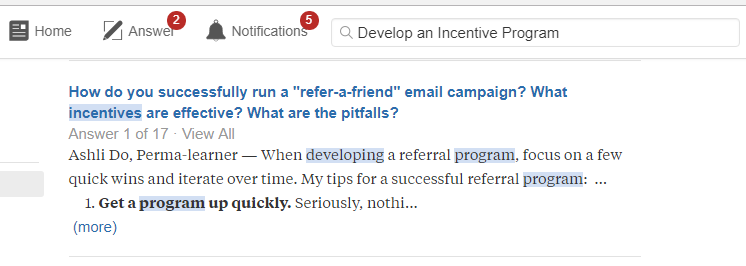
Here’s a process you can follow for repurposing your content:
- Summarize articles and syndicate them on Medium, LinkedIn, and Google+
- Search Quora for sub-headers from your article. Share your article in relevant questions.
- Create a slide deck from your article and share it on Slideshare and Scribd. You can also embed Slideshare presentations on your own site.
- Condense article into informal posts and share them on targeted sub-reddits on Reddit.
Your goal should be to maximize how much value you extract from your content. The wider you spread your net, the more people you’ll be able to reach.
9. Target High-Volume Tangential Keywords
Targeting middle and bottom-of-the-funnel keywords within your industry will be the bread and butter of your content marketing campaign. But you can quickly run out of viable keywords to target with this strategy.
One solution is to focus on high-volume, top-of-the-funnel keywords in tangential industries. that Typically, these are keywords that have an indirect relation to your business.
For example, we created this article on ‘team building activities’ that ranks at the top of the SERPs and brings us thousands of visitors every month.
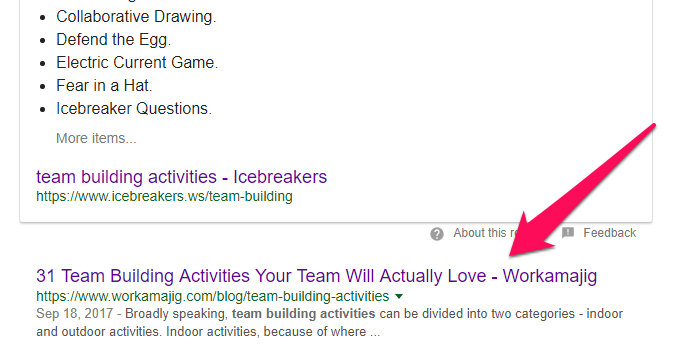
Although “team building activities” isn’t directly related to project management, it is a part of team building, which, in turn, is a part of effective management.
The key benefits of targeting such tangential keywords are:
- Lower competition: Everyone in your industry targets the same industry-specific keywords. But the competition for tangential industry is often lower.
- Higher traffic: Since you’re picking keywords in related industries, you can usually pick high-volume, broad keywords that can bring in substantial traffic.
On the flip side, your leads from such keywords will be untargeted. Be prepared to invest in a lead qualification program to filter out poor quality leads.
10. Scale Lead-Generation from Client Referrals
Client referrals are an excellent source of leads, but they’re hard to scale.
Or are they?
As we showed in an earlier post, scaling client referrals isn’t just possible, it’s downright easy.
Here’s the process in a nutshell:
- Identify your most satisfied clients by using the Net Promoter System (NPS)
- Use LinkedIn to find desirable lead targets from your top clients’ connections.
- Offer personalized incentives for introductions and referrals.
- Reduce friction in sending referrals by creating ready-to-use templates that clients can use in introductions.
- Time your referral ask at positive moments in your relationship (such as project delivery, meeting a key milestone, etc.)
This process works because you only target clients who are happy to recommend others to you (as identified by their NPS scores). By creating templates and asking for specific introductions, you also reduce the friction in sending referrals.
11. Create a Targeted Affiliate Program
You don’t usually think of “agency” when you think of “affiliate programs”. The practice is far more widespread in the software and e-commerce industries.
But agencies can benefit from affiliate programs as well, especially when they are highly targeted.
Conceptually, the process works the same way as any conventional referral program. When someone becomes an affiliate, they get a special link to send you referrals. Any sales attributed to this link earns the referrer a commission.
Marketing agency 180Fusion, for instance, offers separate client referral and affiliate referral programs:
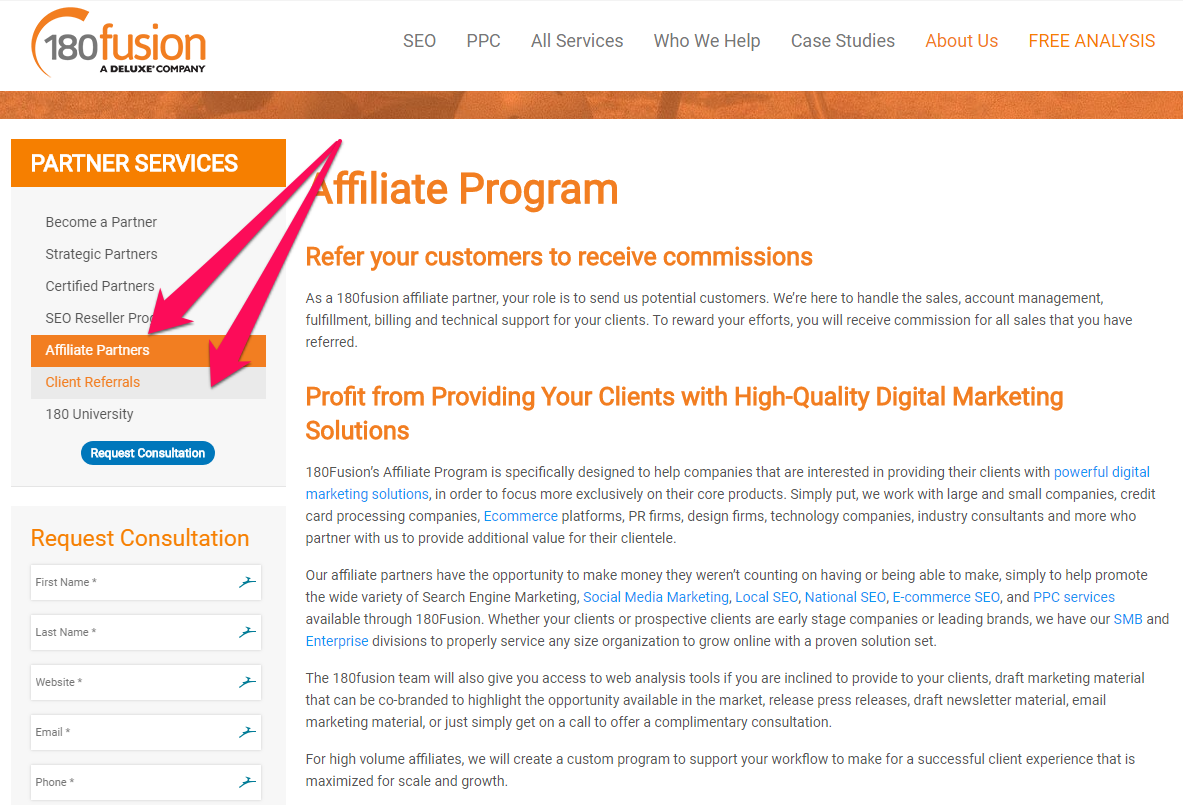
(Image credit: 180Fusion)
The problem with affiliate programs is that it’s not always easy to attribute a sale to a specific referral. There’s also the problem of untargeted leads and referral scams. While lead volume is a good thing, it can quickly become an issue if the leads are consistently low-quality.
The antidote to this problem is to create a closed, invite-only affiliate program that targets influencers. With this approach, you’ll recruit influencers the same way you would land client referrals, that is:
- Find influencers with substantial following in your industry (usually bloggers)
- Create highly targeted landing pages for them to promote your agency services
- Use these personalized landing pages to show your intent when recruiting influencers
You’ll have to pay a generous commission, of course. But influencers will also appreciate if you create promotion assets for them (such as personalized landing pages).
The key benefit of this targeted approach is that it eliminates all tire kickers. Since you have complete control over who gets into the affiliate program, you can remove low quality affiliates. The personalized approach will also help you (and the influencers) improve conversion rates.
The large volume of traffic influencers have access to also means that you can get high-quality leads at scale.
If you’re going to use this tactic, here are some tools you can use to manage affiliates:
12. Create a Lead Capture Plan for Events
Capturing leads from events is easy: show up, network, collect business cards.
The trouble with this passive approach is that you either end up collecting too few or too untargeted leads.
What you need is a comprehensive lead generation plan for events.
Here are a few tips:
Before the event
Before the event starts, ask the organizers for a list of attending companies. Study their websites and identify any that would be a good fit for your agency.
For this list of top prospects, create personalized material that you can hand out during the event. This doesn’t have to be elaborate; a card with the company’s name is more than enough.
PipeCandy, for instance, created greeting cards with the target’s name and a personalized pitch to hand out at events:
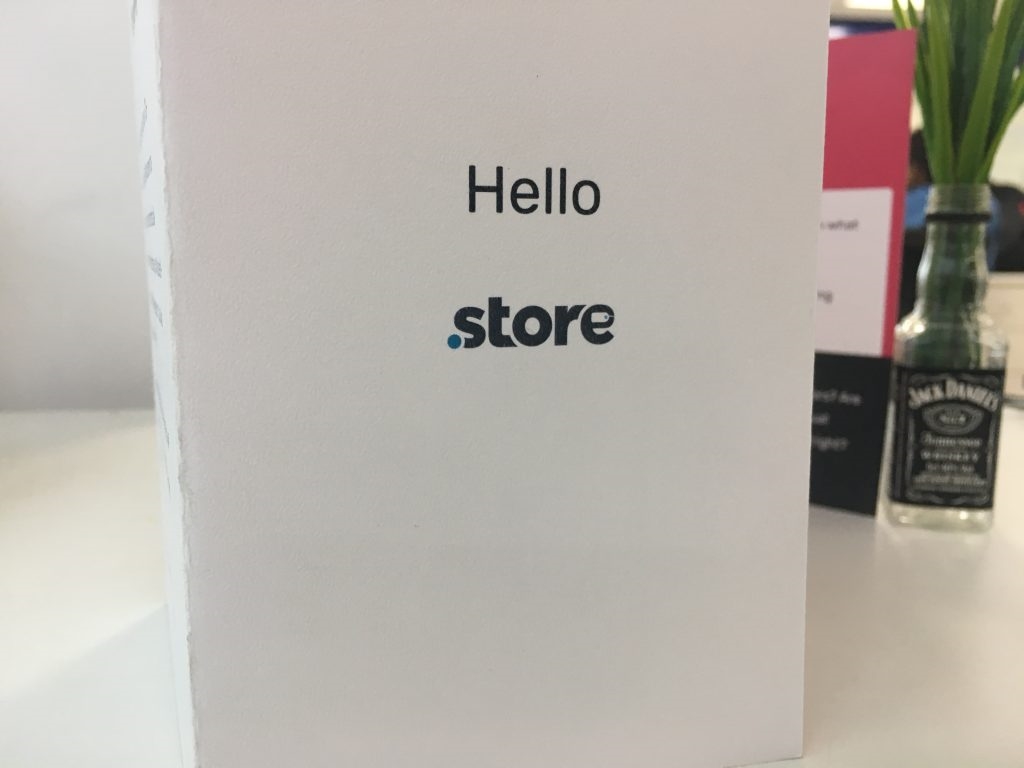
(Image credit: PipeCandy)
Doing your homework before the event makes sure that you won’t just make a great impression, but you’ll also collect high-value leads.
At the event
Events are, first and foremost, about people. Whether it’s a trade show or a conference, selling should take a backseat to building relationships.
That said, your lead generation efforts should be guided by data, not intuition. Supplement badge scans with an optional data-collection form. Make sure that you only ask for relevant data not available through badge scans.
Another tactic you can try is to tie in your event promotions to your content offers. Ask yourself: what are the top “themes” in your content marketing? What are your most popular pieces of content? Is there any way you can bring these content experiences to the event?
For example, your most popular content piece might feature an interview with an influencer. If you can get this influencer to attend the event on your behalf, you can create a more cohesive content experience.
Once you’ve wrapped up the event, make sure to follow-up and schedule phone calls with all targeted leads.
Over to you
It’s never easy to scale lead generation, but these tactics should help. Not all of these will be applicable to your agency. Pick a tactic that fits your budget and current requirements.
What tactics do you use to grow your agency? Share with us in the comments below!
Business & Finance Articles on Business 2 Community
(114)
Report Post


